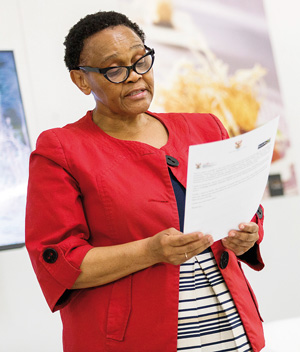Backing these words with action, South African footwear was the protagonist of a promotional tour that brought a selection of manufacturers headed by the Saflec – South African Footwear Leather Export Council to the leading global footwear markets of reference, from America to Europe, Russia, and Turkey.

The meeting with the Italian market occurred during the last edition of Expo Riva Schuh: at the fair in Riva del Garda, the South African Consul-General in Milan, Ms. Titi Nxumalo, announced at a press conference that the South African leather and footwear industry is a strategic industry for her country’s economy, underlining the growing need of South African producers to participate in events like the one in Riva del Garda in order to help boost exports. The Executive Director of Saflec, Nerisha Jairai, instead, outlined the different initiatives launched in favour of South African footwear, thanks to the support of the government:
Our government gives its full support to the leather industry in South Africa and does so in a number of different ways: it supports producers so that they become more competitive, it subsidizes the purchasing of the most technologically innovative machinery, and it sponsors training programs… we have made the most of this support, by starting up important collaborations with Italian institutes, like Assomac for machinery and with the ARSUTORIA SCHOOL for technical training, the development of collections for the international market, and seminars dedicated to fashion trends.
Among the key sectors that is benefitting from the ambitious National Development Plan, which was first launched in 2012 and expected to continue until 2030, is included the leather and footwear industry: thanks to government funding, it returned to a growth trend in 2012, after a negative phase, and today is showing signs of strong growth on all fronts.
Footwear is especially benefitting from this system and, over a period spanning from 2005 to 2015, saw its production increase from 27 million to 61 million pairs. During this same ten-year period, also exports took a leap forward from 1.6 million to 3.5 million pairs, while overall exports from the entire leather, leather goods, and footwear industries grew in value from 1.3 billion rand (1 rand is equal to 0.07 euros) in 2005 to 4.6 billion rand in 2015.

South Africa is also an increasingly interesting consumer market. Always in the decade from 2005 to 2015, the per capita consumption rose from 3.2 to 4.6 pairs, increasing the number of pairs bought from 162 million to 257 million pairs in the domestic footwear market. A demand resulting also in a greater number of imports, which were estimated at a value of 11.8 billion rand in 2015.
It is exactly with these numbers in mind that Assocalzaturifici in 2014 decided to send a business delegation to this country in collaboration with the Johannesburg ICE Agency: “It was an interesting experience – comments Matteo Scarparo, Head of the Global Trade Unit at Assocalzaturifici – Made in Italy generated interest and South Africa undoubtedly represents one of the main markets in Africa. We are monitoring the growth in this country and awaiting future developments”.
South Africa, a country connected to the present
If Africa is the continent of the future, then South Africa is among the African nations in the present that is already experiencing an accelerated trend of economic growth. From the end of the apartheid, the mostly agricultural structure of the country has undergone a process of rapid transformation, and today the service and manufacturing industries account for 29.2% and 68.6% respectively of the GDP, leaving agriculture with only the remaining 2% (source: Farnesina info Mercati Esteri).

With supply chains of worldwide significance in both the agricultural and financial industries, and in extraction engineering and chemical transformation, South Africa is also the main production and car assembly platform for the entire continent at the service of leading global car manufacturers.
The country’s on-going transformation has also been a source of great benefit, increasing the general well-being of the population, while also helping to reduce poverty levels. Of course the gap between rich and poor, especially when it comes to those of colour, remains very high, but the South African government is making great efforts to remedy the situation through a “positive discrimination” campaign supported by the legislation “Broad Based Back Economic Empowerment”, which promotes the hiring of this part of the population by the various South African productive sectors. Similar efforts are being made to reduce the unemployment rate, today calculated at around 25% of the active population, which is also expected to fall thanks to instruments like the National Development Plan set into motion by the South African government in 2012 that calls for ambitious directives in favour of the country’s development from now until to 2030.




